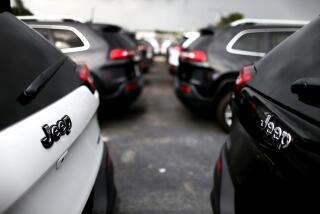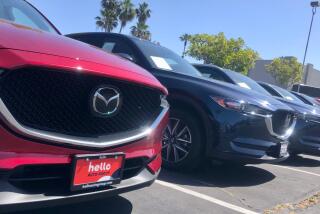At Ford, Damage Control Is Suddenly Job 1
Ford Motor Co. raced into 2000 in high gear, powered by its popular sport-utility vehicles and other top-selling models, a string of newly acquired luxury-car makers such as Volvo and a brash chief executive who is shaking up the company that invented the assembly line.
There was even talk that Ford might soon eclipse General Motors Corp. as the world’s biggest auto maker, a title Ford hasn’t held since it was still being run by founder Henry Ford at the dawn of the Great Depression.
But now the Firestone tire crisis and a rash of other quality snags at Ford--whose familiar slogan is that “Quality is Job 1”--has the company struggling to reassure the world that it is still building reliable, safe vehicles and is being candid with consumers and the government.
Ford probably has the cash reserves to weather the recalls, warranty repairs and court fights stemming from these cases, analysts said. But the rapid-fire sequence of problems is raising questions about whether the auto maker and its chief executive, Jac Nasser, could see their recent achievements clouded if a growing number of consumers begin to doubt Ford’s quality.
Whether Ford can preclude that from happening and keep consumers confident about buying its cars and trucks will determine whether the Dearborn, Mich.-based giant can maintain the momentum that has made it the envy of the automotive world.
“It’s their worst nightmare,” said David Cole, director of the University of Michigan’s Office for the Study of Automotive Transportation. “When you advertise your quality and then the market senses that you’re not delivering, [buyers] question the whole message.”
One issue dogging Ford is the perception--at least among safety advocates and many consumers--that it has remedied defects far too slowly and only after widespread public criticism.
In the case of problem V-6 engines prone to head-gasket failures, for example, the company extended warranty coverage to certain models in three incremental steps that left consumer advocates charging that the company still failed to make good for hundreds of thousands of owners.
“The entire issue will circle around how they handle each of these problems,” said George Peterson, president of AutoPacific Inc., an industry consulting firm in Tustin.
“You can generally maintain your corporate reputation if you handle these things very aggressively and forcefully, and say [to the public], ‘Yes, there’s a problem and we’re going to fix it,’ ” Peterson said.
Ford’s overriding problem, of course, is the crisis surrounding the Firestone tires that equipped many of its Explorers, which have been the country’s best-selling SUVs since their debut a decade ago.
Bridgestone/Firestone Inc. launched a recall of 6.5 million tires in the U.S. on Aug. 9 amid a federal investigation into whether dozens of fatalities might be linked to faulty Firestone brand tires used mostly on Ford light trucks.
Yet Ford is grappling with other quality setbacks, too.
Judge Hints at a Massive Recall
On Tuesday, a California Superior Court judge--ruling in the largest class-action lawsuit ever filed against a U.S. auto maker--said he might order a recall of as many as 2 million Ford vehicles over concerns that they are prone to stalling because of a faulty ignition/electrical setup. The recall would cover dozens of Ford models built between 1983 and 1995.
Ford also has been hobbled all year by problems associated with a 3.8-liter V-6 engine installed in a variety of cars and minivans, ranging from the Mustang to the Windstar, because the engine is prone to head-gasket failure. In May, Ford for the third time expanded warranty coverage in addressing the problem, and now more than 1 million vehicles are involved. There is also at least one class-action lawsuit being mounted on behalf of owners of the vehicles.
Ford executives deny that the defect problems indicate any breakdown in the auto maker’s commitment to quality and safety.
“We are a victim of circumstances here,” said Ken Zino, a Ford spokesman. “Certainly with the tire recall, we moved as quickly as we could, once we understood what was going on.”
But he conceded that Ford’s image is taking a beating: “Any time you have a recall, it has an effect on reputation.”
The company also acknowledged that negative publicity is starting to turn off auto buyers and hurt Explorer sales. The car maker, which will release August sales figures this week, is expecting Explorer sales to drop “a couple of percentage points” from the levels of a year ago, Zino said.
In July, before the Firestone fiasco surfaced, Ford sold 39,550 Explorers, up 15% from July 1999.
To be sure, faulty parts and model recalls are hardly new in the auto industry. And some analysts are not convinced that a significant number of consumers are going to start second-guessing whether to buy a Ford because of the company’s recent setbacks.
“I don’t think it will have a negative impact” on Ford’s overall sales, said Michael Bruynesteyn, an analyst at Prudential Securities. “There are recalls every year, and there are court cases that Ford and GM and DaimlerChrysler then win on appeal every year.
“Clearly the Firestone situation is worse than anything we’ve seen,” he said, “but the Explorer is not going to be damaged over the long term. Ford is actively managing this situation, and they’re doing the best they can.”
David Healy, an analyst at Burnham Securities, said that “the tire recall with its nasty, daily headlines has some potential for slowing things down temporarily” for Ford, “but I think, frankly, it will blow over.”
Still, Ford’s effort will come under further scrutiny when Congress holds hearings on the Firestone situation beginning next week. A House Commerce Committee hearing is set for Wednesday, and a Senate Commerce Committee hearing, originally set for the same day, is now scheduled for Sept. 12.
Nasser so far has declined to appear at the House hearing, which drew complaints from some lawmakers. But Ford said Wednesday that both congressional committees agreed to accept two other Ford executives at their hearings.
Regardless, some auto-safety groups noted that Nasser is appearing in television commercials to defend his company.
“Ford’s reputation is on the line here,” said Clarence Ditlow, executive director at the Center for Auto Safety in Washington.
Meanwhile, Venezuela’s consumer protection agency is scheduled to unveil today a report on the results of its investigation of deaths blamed on failed Firestone tires on Ford vehicles in that country.
Samuel Ruh Rios, head of the consumer protection agency known as Indecu, was quoted in the El Universal newspaper Wednesday as saying the report will find that Ford and Firestone share the blame for the accidents. Moreover, the agency’s chief inspector told El Nacional newspaper that the probe indicates some of the accidents involving Ford Explorers were caused by problems other than faulty tires.
The report will be turned over to prosecutors so a criminal case can be pursued. Congressional deputies also have said a legislative inquiry is likely.
$163 Billion in Sales Last Year
Ford, like GM, is a behemoth by almost any measure. Ford’s sales last year totaled $163 billion, and it sold 7.2 million vehicles around the globe. The company has more than 350,000 employees and 150 manufacturing plants worldwide.
Under Nasser’s direction, Ford has been buying up other companies to expand its line of higher-profit luxury cars.
Ford--whose other domestic brands are Lincoln and Mercury--last year paid $6.5 billion for the car division of Volvo of Sweden, adding to foreign holdings that include Jaguar and Aston Martin of England. Last month Ford bought British SUV maker Land Rover, and it owns a controlling stake in Mazda Motor Corp. of Japan.
Beyond making global deals, Nasser also is boldly trying to change Ford’s culture: pushing the company to develop new models faster, cutting operating costs, hiring dozens of outsiders for top positions across its divisions and, in a novel move for Ford, at least, tying executives’ pay to the performance of the company’s stock.
The stock, though, has taken a beating in the aftermath of the Firestone mess, and it has lost 11% of its value so far this year. However, it gained 63 cents Wednesday, closing at $25.88 a share on the New York Stock Exchange.
In the faulty car-ignition case, the class-action suit was brought on behalf of more than 3 million California residents who now or formerly owned Ford vehicles equipped with “thick-film ignition modules.” An estimated 1.8 million TFI-equipped vehicles are still on the road and, under the judge’s tentative ruling, they could be recalled or their owners could be reimbursed by Ford if they replaced the failed modules on their own.
Either way, the decision by Alameda County Superior Court Judge Michael E. Ballachey could cost Ford more than $100 million, though his ruling could be revised after he holds more hearings Sept. 28-29.
The TFI module is a device that regulates the flow of electrical current to spark plugs. Between 1983 and 1995, Ford installed them on about 22 million Ford, Lincoln and Mercury vehicles. Plaintiffs’ lawyers allege that Ford’s decision to mount the device on the distributor exposed it to excessive heat, causing a high rate of TFI failures and serious problems with vehicles stalling, both when started up and at highway speeds.
Ford argues that there is no significant difference in the number of failures of TFI modules mounted on distributors versus remote-mounted ones, and no evidence of any injuries or deaths caused by the problem.
But Ballachey said evidence shows that Ford was aware that mounting the modules on distributors would make them “vulnerable to ‘thermal stress.’ ”
*
Times staff writers Myron Levin and Sebastian Rotella contributed to this report.







